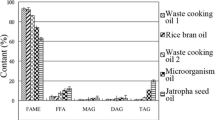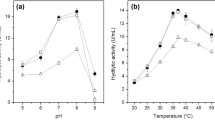Abstract
A 46% γ-linolenic acid (GLA)-containing oil was produced by selective hydrolysis of borage oil (GLA content, 22%) at 35°C for 15 h in a mixture containing 50% water and 20 units (U)/g reaction mixture of Candida rugosa lipase. The GLA content was not raised over 46%, even though the hydrolysis extent was increased by extending the reaction time and by using a larger amount of the lipase. However, 49% GLA-containing oil was produced by hydrolysis in a reaction mixture with 90% water. This result suggested that free fatty acids (FFA) that accumulated in the mixture affected the apparent fatty acid specificity of the lipase in the selective hydrolysis and interfered with the increase of the GLA content. To investigate the kinetics of the selective hydrolysis in a mixture without FFA, glycerides containing 22, 35, and 46% GLA were hydrolyzed with Candida lipase. The result showed that the hydrolysis rate decreased with increasing GLA content of glycerides, but that the release rate of GLA did not change. Thus, it was found that the apparent fatty acid specificity of the lipase in the selective hydrolysis was also affected by glyceride structure. When 46% GLA-containing oil was hydrolyzed at 35°C for 15 h in a mixture containing 50% water and 20 U/g of the lipase, GLA content in glycerides was raised to 54% at 20% hydrolysis. Furthermore, GLA content in glycerides was raised to 59% when the hydrolysis extent reached 60% using 200 U/g of the lipase. These results showed that repeated hydrolysis was effective to produce the higher concentration of GLA oil. Because film distillation was found to be extremely effective for separating FFA and glycerides, large-scale hydrolysis of borage oil was attempted. As a result, 1.5 kg of 56% GLA-containing oil was obtained from 7 kg borage oil by repeated reaction.
Similar content being viewed by others
References
Wu, D., and S.N. Meydani, γ-Linolenic Acid and Immune Function, in γ-Linolenic Acid: Metabolism and Its Roles in Nutrition and Medicine, edited by Y.-S. Huang and D.E. Mills, AOCS Press, Champaign, 1996, pp. 106–117.
Crozier, G.L., and M.-C. Secretin, Secretin, γ-Linolenic Acid in Infant Formula, Ibid., edited by Y.-S. Huang and D.E. Mills, AOCS Press, Champaign, 1996, pp. 246–251.
Traitler, H., H.J. Wille, and A. Studer, Fractionation of Black-currant Seed Oil, J. Am. Oil Chem. Soc. 65:755–760 (1988).
Arai, M., H. Fukuda, and H. Morikawa, Selective Separation of γ-Linolenic Acid Ethyl Ester Using Y-Zeolite, J. Ferment. Technol. 65:569–574 (1987).
Yokochi, T., M.T. Usita, Y. Kamisaka, T. Nakahara, and O. Suzuki, Increase in the γ-Linolenic Acid Content by Solvent Winterization of Fungal Oil Extracted from Mortierrella Genus, J. Am. Oil Chem. Soc. 67:846–851 (1990).
Syed Rahmatullah, M.S.K., V.K.S. Shukla, and K.D. Mukherjee, Enrichment of γ-Linolenic Acid from Evening Primrose Oil and Borage Oil via Lipase-Catalyzed Hydrolysis, Ibid.:569–573 (1994).
Syed Rahmatullah, M.S.K., V.K.S. Shukla, and K.D. Mukherjee, γ-Linolenic Acid Concentrates from Borage and Evening Primrose Oil Fatty Acids via Lipase-Catalyzed Esterification. Ibid.:563–567 (1994).
Foglia, T.A., and P.E. Sonnet, Fatty Acid Selectivity of Lipases: γ-Linolenic Acid from Borage Oil, Ibid.:417–420 (1995).
Huang, F-C., Y-H. Ju, and C-W. Huang, Enrichment of γ-Linolenic Acid from Borage Oil via Lipase-Catalyzed Reactions, Ibid.:977–981 (1997).
Shimada, Y., A. Sugihara, M. Shibahiraki, H. Fujita, H. Nakano, T. Nagao, T. Terai, and Y. Tominaga, Purification of γ-Linolenic Acid from Borage Oil by a Two-Step Enzymatic Method, Ibid.:1465–1470 (1997).
Yang, L.Y., A. Kuksis, and J.J. Myher, Lipolysis of Menhaden Oil Triacylglycerols and the Corresponding Fatty Acid Alkyl Esters by Pancreatic Lipase in Vitro: A Reexamination, J. Lipid Res. 31:137–148 (1990).
Shimada, Y., A. Sugihara, H. Nakano, T. Nagao, M. Suenaga, S. Nakai, and Y. Tominaga, Fatty Acid Specificity of Rhizopus delemar Lipase in Acidolysis, J. Ferment. Bioeng. 83:321–327 (1997).
Tanaka, Y., J. Hirano, and T. Funada, Concentration of Docosahexaenoic Acid in Glyceride by Hydrolysis of Fish Oil with Candida cylindracea Lipase, J. Am. Oil Chem. Soc. 69:1210–1214 (1992).
Shimada, Y., K. Maruyama, S. Okazaki, M. Nakamura, A. Sugihara, and Y. Tominaga, Enrichment of Polyunsaturated Fatty Acids with Geotrichum candidum Lipase, Ibid.:951–954 (1994).
Shimada, Y., A. Sugihara, K. Maruyama, T. Nagao, S. Nakayama, H. Nakano, and Y. Tominaga, Enrichment of Arachidonic Acid: Selective Hydrolysis of a Single-Cell Oil from Mortierella with Candida cylindracea Lipase, Ibid.:1323–1327 (1995).
Shimada, Y., K. Maruyama, M. Nakamura, S. Nakayama, A. Sugihara, and Y. Tominaga, Selective Hydrolysis of Polyunsaturated Fatty Acid-Containing Oil with Geotrichum candidum Lipase, Ibid.:1577–1581 (1995).
Shimada, Y., K. Maruyama, A. Sugihara, S. Moriyama, Y. Tominaga, Purification of Docosahexaenoic Acid from Tuna Oil by a Two-Step Enzymatic Method: Hydrolysis and Selective Esterification, Ibid.:1441–1446 (1997).
Sugihara, A., Y. Shimada, and Y. Tominaga, Separation and Characterization of Two Molecular Forms of Geotrichum candidum Lipase, J. Biochem. 107:426–430 (1990).
Iwai, M., Y. Tsujisaka, and J. Fukumoto, Studies on Lipase. II. Hydrolytic and Esterifying Actions of Crystalline Lipase of Aspergillus niger, J. Gen. Appl. Microbiol. 10:13–22 (1964).
Okumura, S., M. Iwai, and Y. Tsujisaka, The Effect of Reverse Action on Triglyceride Hydrolysis by Lipase, Agric. Biol. Chem. 45:185–189 (1981).
Tanaka, Y., T. Funada, J. Hirano, and R. Hashizume, Triglyceride Specificity of Candida cylindracea Lipase: Effect of Docosahexaenoic Acid on Resistance of Triglyceride to Lipase, J. Am. Oil Chem. Soc. 70:1031–1034 (1993).
Author information
Authors and Affiliations
Corresponding author
About this article
Cite this article
Shimada, Y., Fukushima, N., Fujita, H. et al. Selective hydrolysis of borage oil with Candida rugosa lipase: Two factors affecting the reaction. J Amer Oil Chem Soc 75, 1581–1586 (1998). https://doi.org/10.1007/s11746-998-0097-5
Received:
Accepted:
Issue Date:
DOI: https://doi.org/10.1007/s11746-998-0097-5




